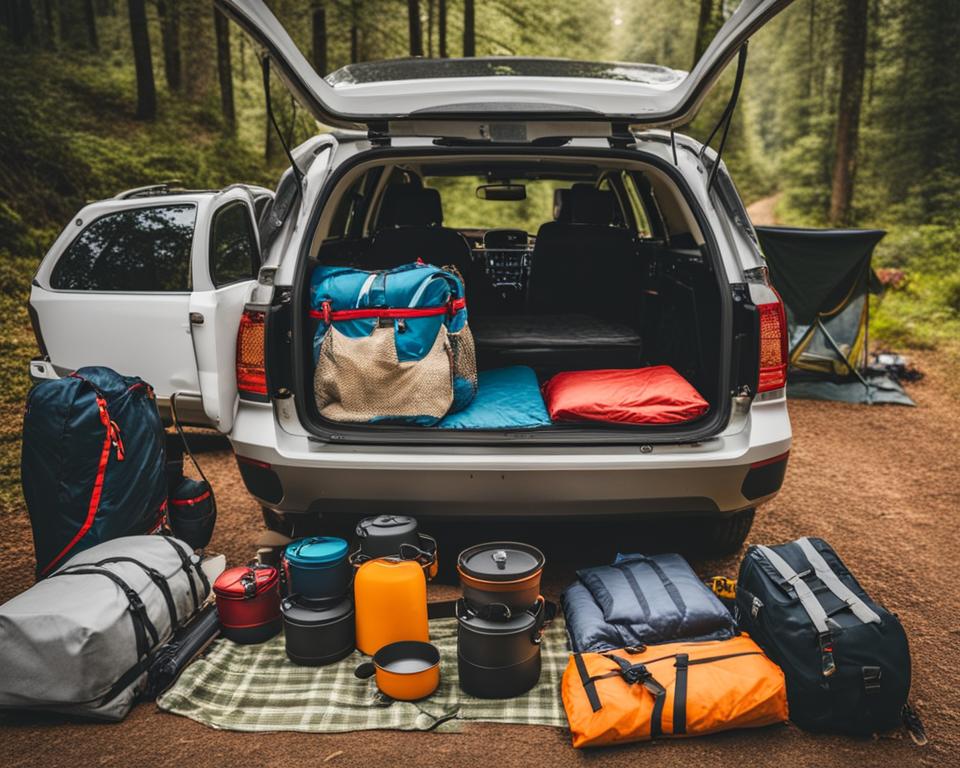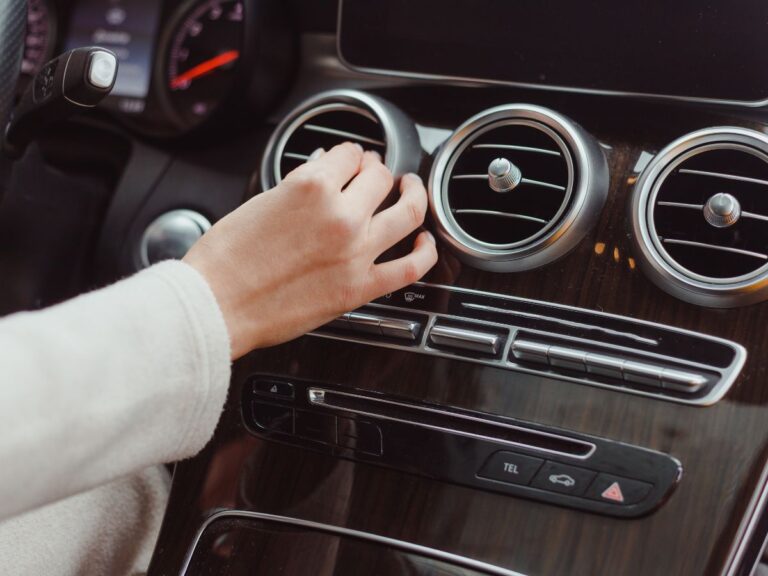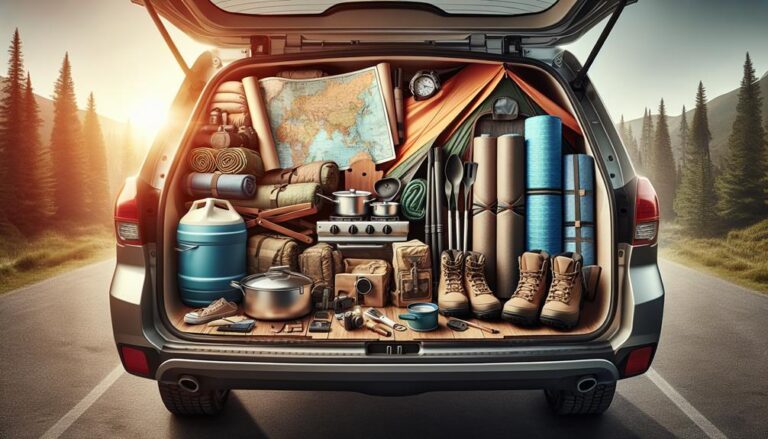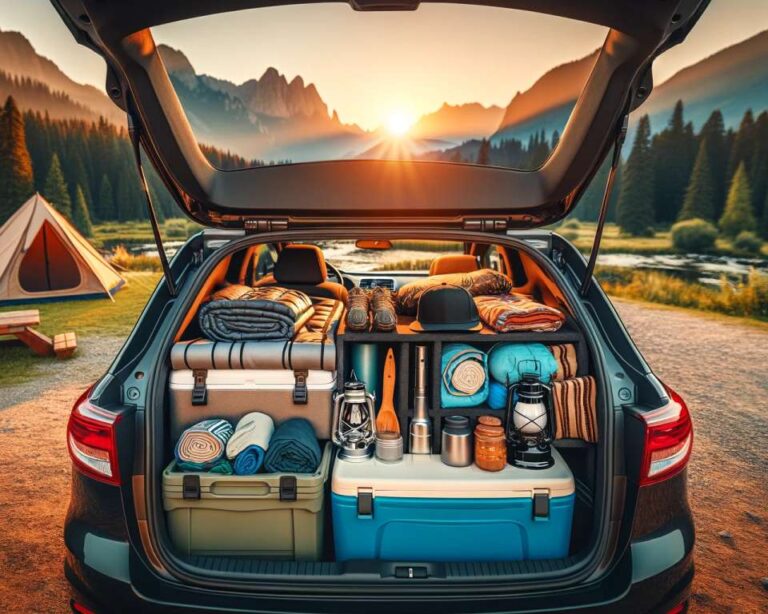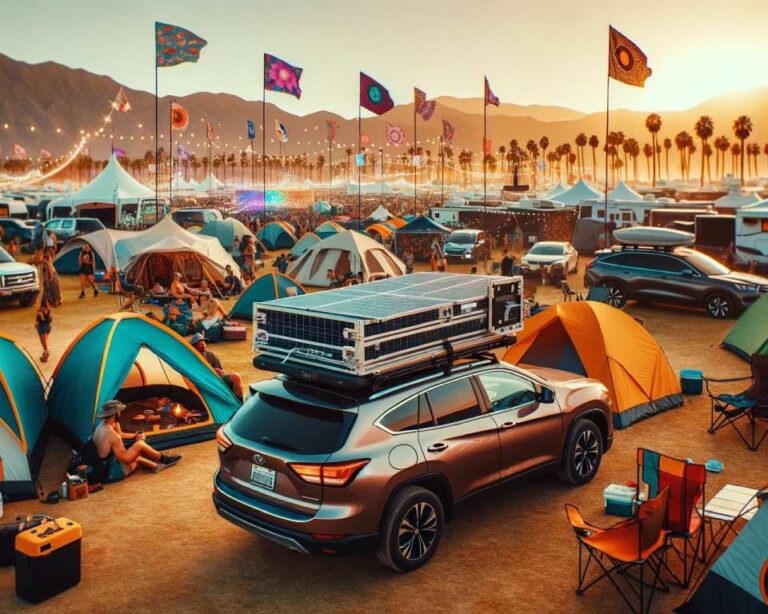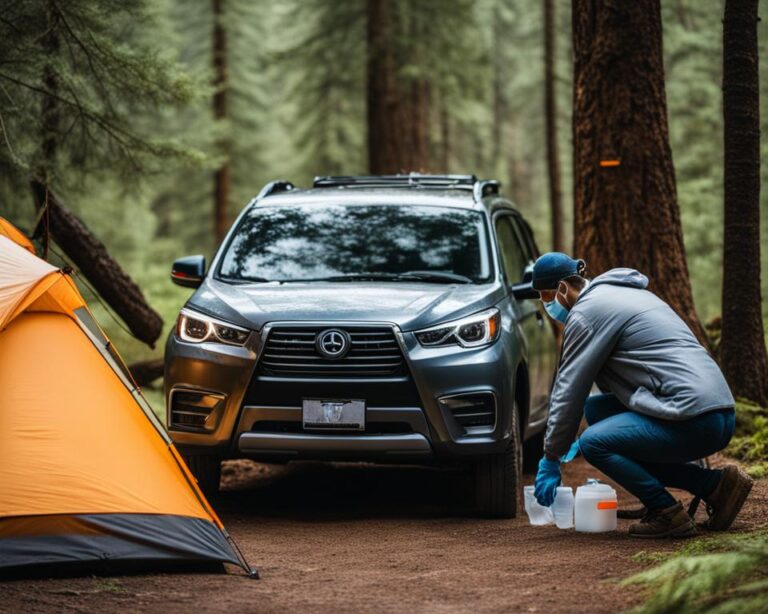Safe Car Camping Practices: Ensuring Secure and Comfortable Overnight Stays
Car camping is a popular way to enjoy the outdoors, but it’s important to prioritize safety and comfort during overnight stays. By following these car camping practices, you can ensure a secure and enjoyable experience. These tips cover everything from researching overnight parking regulations to being aware of your surroundings and having the necessary safety gear.
When it comes to car camping, preparation is key. Whether you’re a seasoned pro or new to the world of car camping, having a checklist of essential items and knowing the best practices can make a world of difference in your overall experience. That’s why we’ve put together this comprehensive guide to help you stay safe and comfortable while exploring the great outdoors.
Throughout this article, we’ll cover various aspects of car camping, providing valuable tips and insights to ensure that you have all the information you need for a successful trip. From researching overnight parking regulations to choosing the right vehicle and packing essential gear, we’ve got you covered.
So, if you’re ready to embark on your next car camping adventure, let’s dive in and discover the safe and practical practices that will help make your journey memorable and worry-free!
Researching Overnight Parking Regulations
Before embarking on your car camping adventure, it’s important to familiarize yourself with the local regulations regarding overnight parking. Understanding the rules and restrictions in the area you plan to camp will help ensure a safe and hassle-free experience. Here are some car camping safety tips to help you navigate overnight parking regulations:
1. Know the Local Ordinances
Research the city and state ordinances pertaining to car camping and overnight parking in the areas you intend to visit. Different regions may have varying rules and restrictions, including designated car camping spots, parking times, and limitations on overnight stays. Familiarize yourself with these regulations to avoid any potential legal issues.
2. Utilize Online Resources
Take advantage of online resources such as iOverlander and Freecampsites.net to find free car camping spots. These platforms provide information about safe and legal overnight parking locations, including user reviews and ratings. However, it’s important to remember that these listings may not always be up to date, so it’s crucial to double-check by calling the facility or conducting further research.
3. Call Ahead to Confirm Policies
When you find a potential car camping spot, always call ahead to confirm their policies on overnight parking. Some establishments, such as rest areas, businesses, and parks, may have specific guidelines or permits required for car camping. By verifying the details beforehand, you can ensure that your chosen location is suitable and complies with the regulations.
Driving Safety Tips
When it comes to safe car camping practices, driving at night requires extra caution. According to the National Highway Traffic Safety Administration, the risk of accidents increases during nighttime driving. To ensure a safe journey, here are some essential driving safety tips to keep in mind:
- Ensure your vehicle is in good condition: Before embarking on your car camping adventure, make sure your car is well-maintained. Regularly check the tire pressure, brakes, and fluid levels. Additionally, ensure your headlights are clean and working properly for optimal visibility during nighttime driving.
- Be aware of your surroundings: Stay mindful of your surroundings while on the road. Keep an eye out for pedestrians, wildlife, and unexpected hazards. Avoid distractions, such as using your phone or adjusting the radio, and maintain a focused mindset to react promptly to any potential risks.
- Plan your route: Before hitting the road, plan your route carefully to avoid any unfamiliar or hazardous areas. Utilize GPS or navigation apps to stay on track and minimize the chances of getting lost. Additionally, identify well-lit and safe areas for rest stops during your car camping journey.
- Avoid driving at night whenever possible: While it may not always be avoidable, it’s best to limit nighttime driving during your car camping trips. Reduced visibility, fatigue, and potential drowsiness increase the likelihood of accidents. Plan your journey in a way that allows you to arrive at your destination before sunset whenever feasible.
Remember, safe car camping practices extend beyond the campsite. Taking precautions while driving at night significantly contributes to a secure and enjoyable car camping experience.

Being Aware of Your Surroundings
When it comes to car camping, personal safety should always be a top priority. Being aware of your surroundings is essential to ensure a secure and enjoyable experience, especially if you’re solo car camping. Here are some important tips to keep in mind:
- Avoid opening your trunk in crowded areas: When you arrive at your overnight parking spot, it’s best to avoid drawing unnecessary attention to yourself or your belongings. Opening your trunk in crowded areas can make you vulnerable to theft or unwanted attention. Instead, find a quiet and secluded spot to organize your camping gear.
- Be cautious of anyone following you: While choosing an overnight parking spot, be vigilant of any suspicious individuals who may be following you. If you notice someone acting strangely or tailing your vehicle, it’s crucial to trust your instincts and find a safer location.
- Set up your sleeping area before parking: To prioritize personal safety, consider setting up your sleeping area inside your vehicle before parking for the night. This way, you don’t have to leave the safety of your car to arrange your sleeping arrangements in potentially unfamiliar surroundings.
- Trust your instincts: Your gut feeling is your best guide. If you feel unsure or uncomfortable about your surroundings or the people nearby, it’s essential to listen to your instincts. Don’t hesitate to leave the area and find an alternative location where you feel more secure.
By being mindful of your surroundings and taking necessary precautions, you can ensure a safer and more enjoyable solo car camping experience.
“Personal safety is of utmost importance during car camping. Always be cautious, trust your instincts, and create an environment that prioritizes your security and peace of mind.”
Sharing Your Location
When it comes to car camping, safety should always be a top priority. One important safety tip is to share your location with a trusted family member or friend before embarking on your trip. By sharing your location, you give them peace of mind and create an extra layer of security for yourself.
There are several ways to share your location while car camping. Many smartphones have built-in location sharing features that allow you to share your real-time location with specific contacts. By using this feature, your loved ones can track your whereabouts and know that you are safe.
If your phone doesn’t have a location sharing feature, or if you prefer a different method, you can simply share your travel plans with someone you trust. Let them know where you plan to camp, which routes you’ll be taking, and any other relevant information. This way, they will have a general idea of your location and can help if an emergency arises.
Remember, sharing your location is not only beneficial for emergencies but also for day-to-day situations. If you encounter any difficulties or need assistance while car camping, having someone who knows your location can make it easier for them to find and help you.
“Sharing your location with a trusted contact ensures that someone knows where you are and can provide assistance in case of an emergency.”
By implementing this simple safety precaution, you can enjoy your car camping experience with peace of mind, knowing that someone is looking out for you. Stay safe and happy camping!

Self-Defense and Safety Gear
When embarking on a car camping adventure, it’s essential to prioritize your personal safety. Carrying self-defense tools can provide a sense of security and peace of mind during your trip. Two common options for self-defense in the outdoors are bear spray and mace.
Bear Spray
Bear spray is specifically designed to deter and repel bears in case of an encounter. It typically contains capsaicin, a natural compound derived from chili peppers, which creates a cloud of irritants that affects the bear’s senses, giving you time to retreat safely. Before purchasing bear spray, familiarize yourself with the specific regulations and guidelines for its use in the area where you will be camping.
Mace
Mace, on the other hand, is a general-purpose self-defense spray that can be used against both humans and animals. It typically contains oleoresin capsicum, a concentrated formula that affects the eyes, throat, and respiratory system of the attacker, giving you a chance to escape from a potentially dangerous situation.
Remember, using self-defense tools comes with great responsibility. It is crucial to understand how to use them effectively and responsibly. Familiarize yourself with the manufacturer’s instructions and practice using them safely before your trip.
In addition to self-defense tools, it is also recommended to carry a basic first aid kit and any other safety gear that may be appropriate for your car camping activities. A well-equipped first aid kit can help you handle minor injuries and provide necessary medical assistance until further help arrives.
Roadside Assistance
Purchasing a roadside assistance service is one of the essential car camping essentials you shouldn’t overlook. When you’re out in remote areas or unfamiliar surroundings, a breakdown or vehicle-related issue can quickly turn into a stressful situation. That’s where roadside assistance comes to your rescue. One highly recommended option is the AAA membership.
With AAA, you’ll have peace of mind knowing that help is just a phone call away. They offer a range of services, including tire changes, jump-starts, and fuel delivery, to get you back on the road and continue enjoying your car camping adventure.
“Roadside assistance provides immediate help when you need it the most. It’s like having a guardian angel watching over you, ready to lend a hand.” – Car Camping Enthusiast
Why Choose AAA?
- AAA is a reputable and trusted name in the automotive industry, known for their reliable service and assistance.
- Their extensive network ensures coverage in many areas, even in remote locations.
- AAA offers a variety of membership levels, allowing you to choose the one that best fits your needs and budget.
- Membership benefits extend beyond roadside assistance to include travel discounts, trip planning services, and exclusive member deals.
While roadside assistance is invaluable, it’s important to have a backup plan in case you can’t reach them at certain hours or in remote areas. Familiarize yourself with alternative options available in the areas you plan to travel to.
Remember, investing in a dependable roadside assistance service like AAA can be a game-changer when it comes to ensuring a smooth and stress-free car camping experience.
Car Emergency Kit
When it comes to car camping, preparedness is key. One essential item that should be included in your car camping checklist is a comprehensive car emergency kit. This kit contains emergency supplies and tools that can come in handy during unforeseen circumstances on the road. Being prepared not only ensures your safety but also adds peace of mind to your car camping experience.

Here are some emergency supplies and car maintenance tools that should be included in your car emergency kit:
1. Flat Tire Kit:
- Tire jack
- Tire pressure gauge
- Spare tire
- Tire repair kit
2. First Aid Kit:
- Bandages, gauze, and adhesive tape
- Antiseptic wipes or solution
- Pain relievers
- Tweezers and scissors
3. Jumper Cables:
Carrying jumper cables is essential in case your car battery dies. This allows you to jump-start your vehicle and get back on the road.
4. Basic Tools:
- Screwdriver set
- Adjustable wrench
- Pliers
- Knife
5. Additional Supplies:
- Flashlight and extra batteries
- Reflective warning triangle
- Emergency blanket
- Water and non-perishable snacks
Remember to tailor your car emergency kit to include items specific to your car and potential weather conditions. For example, if you’re traveling to a cold climate, include items like ice scrapers, a shovel, and warm blankets. Regularly check and replenish your emergency kit to ensure that all items are in good condition and up to date.
Always be prepared for the unexpected. A well-equipped car emergency kit can be a lifesaver during car camping adventures. It’s better to have it and not need it than to need it and not have it.
Car Maintenance and Knowledge
As car campers, it’s essential to prioritize car maintenance to ensure a safe and smooth journey. Regularly servicing your vehicle and performing basic car care tasks not only prevent problems on the road but also contribute to a seamless car camping experience.
Familiarize yourself with your car’s owner’s manual, as it provides valuable information on maintenance schedules and procedures specific to your vehicle. This knowledge empowers you to take proper care of your car and address any issues promptly.
1. Regular Servicing
Schedule routine maintenance visits to your trusted mechanic or dealership to keep your vehicle in optimal condition. Regular servicing includes tasks like oil changes, filter replacement, and brake inspections. These preventive measures help avoid breakdowns and prolong the lifespan of your car.
2. Tire Care
Proper tire maintenance is crucial for both safety and fuel efficiency. Check the tire pressure regularly using a gauge and ensure it matches the recommended levels specified in your owner’s manual. Inspect the tread depth to ensure it’s within the legal limit and rotate the tires as recommended to promote even wear.
3. Changing a Tire
Knowing how to change a tire is a valuable skill for any car camper. In the event of a flat tire, follow these steps:
- Park your vehicle on a flat surface away from traffic and engage the parking brake.
- Use a jack to lift your car off the ground, placing it securely on the appropriate point specified in your owner’s manual.
- Remove the flat tire and replace it with the spare tire, ensuring it’s securely attached.
- Tighten the wheel nuts in a star pattern using a wrench, being careful not to overtighten.
- Lower the vehicle and check the tire pressure of the spare tire.
4. Fluid Checks
Regularly check the fluid levels in your vehicle, including engine oil, coolant, brake fluid, and windshield washer fluid. Low levels can cause significant damage or compromise your car’s performance. Consult your owner’s manual for guidance on checking and topping up these fluids.

“Regular car maintenance is essential for a hassle-free car camping experience. By taking care of your vehicle and addressing any issues promptly, you can focus on enjoying the great outdoors without worrying about mechanical problems.”
By staying on top of car maintenance and gaining basic car care knowledge, you can enjoy a worry-free car camping adventure. Remember, a well-maintained car is the foundation for a successful and enjoyable trip.
Choosing the Right Vehicle for Car Camping
When it comes to car camping, selecting the right vehicle is essential for a comfortable and convenient outdoor experience. Consider various factors, such as cargo space, weight capacity, and off-road capabilities when choosing a car for your camping adventures.
Popular choices for car camping include SUVs, vans, and trucks, thanks to their ample storage options and rugged performance. These vehicles offer enough space to accommodate camping gear, such as tents, sleeping bags, and cooking equipment. However, even smaller cars can be suitable for car camping with the right setup.
Before making a decision, evaluate your specific needs and budget. Determine the number of people you plan to camp with and the type of terrain you’ll encounter. If you prefer off-road camping in remote areas, a vehicle with 4-wheel drive and a higher ground clearance may be ideal.
Remember, investing in a roof rack or car-top carrier can significantly increase your storage capacity, allowing you to bring more camping gear along. Ultimately, the best car for car camping is the one that meets your requirements, ensuring a comfortable and enjoyable outdoor adventure.
FAQ
What are some car camping practices to ensure a secure and comfortable overnight stay?
Follow these car camping practices to prioritize safety and comfort during overnight stays. Research overnight parking regulations, drive safely, be aware of your surroundings, share your location, carry self-defense and safety gear, have roadside assistance, maintain a car emergency kit, and stay on top of car maintenance.
How can I research overnight parking regulations for car camping?
Before arriving at your overnight spot, do your research on local city and state ordinances concerning car camping and overnight parking. Utilize resources like iOverlander and Freecampsites.net to find free places to sleep, and always call the facility beforehand to confirm their policies.
What are some tips for driving safely during car camping?
It’s best to avoid driving at night whenever possible. Ensure your car is in good condition with clean headlights and optimal visibility. Be aware of your surroundings and avoid distractions while driving.
How can I be aware of my surroundings while car camping?
Avoid opening your trunk in crowded areas and be cautious of anyone who may be following you to your overnight parking spot. Set up your sleeping area before parking, so you don’t have to leave the safety of your car. Trust your instincts and be ready to leave if you feel unsure about your surroundings.
Should I share my location while car camping?
Yes, it’s recommended to share your location with a trusted family member or friend. Consider using location sharing features on your phone or sharing your travel plans before embarking on your car camping trip. This ensures that someone knows where you are and can help in case of an emergency.
What self-defense and safety gear should I carry while car camping?
Consider carrying self-defense tools like bear spray or mace for a sense of security. Make sure you are knowledgeable about how to use these tools effectively and responsibly. Additionally, carry a basic first aid kit and any other safety gear appropriate for your car camping activities.
Is roadside assistance important for car campers?
Yes, purchasing a roadside assistance service like AAA is highly recommended for car campers. This provides peace of mind in case of a breakdown or other vehicle-related issues. However, it’s also important to have a backup plan in case you can’t reach them at certain hours or in remote areas.
What should I include in my car emergency kit for car camping?
Always have a car emergency kit with essential supplies, including a flat tire kit, first aid kit, jumper cables, and basic tools. Tailor your kit to include items specific to your car and potential weather conditions. Being prepared for unforeseen circumstances can make a significant difference in your car camping experience.
How can I stay on top of car maintenance for car camping?
Stay on top of car maintenance by regularly servicing your vehicle and knowing how to perform basic car care tasks. Familiarize yourself with your car’s owner’s manual and understand how to check tire pressure, change a tire, and perform regular oil changes. Having a basic understanding of your vehicle can help prevent problems and ensure a safe car camping experience.
What factors should I consider when choosing a vehicle for car camping?
When choosing a vehicle for car camping, consider factors such as cargo space, weight capacity, and off-road capabilities. SUVs, vans, and trucks are popular choices, but even small cars can be suitable with the right setup. Evaluate your specific needs and budget to find the ideal vehicle for your car camping adventures.

